A good inflatable paddleboard can be a considerable investment. As such, you need to take proper care of your board to prolong its useable life span. Even though they are designed to be deflated and packed away, doing so incorrectly can, over time, cause irreparable damage to your board. Here we give you a step-by-step guide to show you correctly how to deflate a paddle board and pack it away.
The Steps of Deflating And Packing A Paddle Board
- Wash the board and paddle with fresh water to remove dirt, salt, or aquatic organisms.
- Remove any detachable fins from the board
- Allow the board to dry fully, either naturally or with a towel.
- Open the inflation valve by pushing in the pin and turning 90 degrees anticlockwise, and let the board naturally deflate.
- Fold the board towards the open valve, squeezing all the air out.
- With all the air out of the board, close the valve and dust cap, and unfold the deflated board.
- Carefully fold the board around the fin box, ensuring not to bend the material around the fin box and fold from tail to nose.
- Tie up the board with straps and place it into the carrying bag.
How To Deflate A Paddle Board
Choose a Suitable Location
A top tip to caring for your board when deflating it is to always deflate your paddle board on clean and flat ground, away from sharp rocks, stones, and sand. This will prevent abrasions and scratches and also hugely reduce the likelihood of getting a puncture.
If your only option is on a sandy beach, on grass, or any other sub-optimal surface, you can use a tarp or a specifically designed paddle board landing mat to protect your board from sharp objects and to keep it clean.
Wash Your Paddle Board With Fresh Water
Rinsing your board after every use is one of the easiest and most important steps you can do to prolong the life and quality of your inflatable paddle board. This is particularly important when using your board in salt water as the salt will degrade the material, and it will attract moisture when stored, which further causes problems. Mould, mildew, and a peeling deck pad can occur if your board is left damp for an extended period of time.
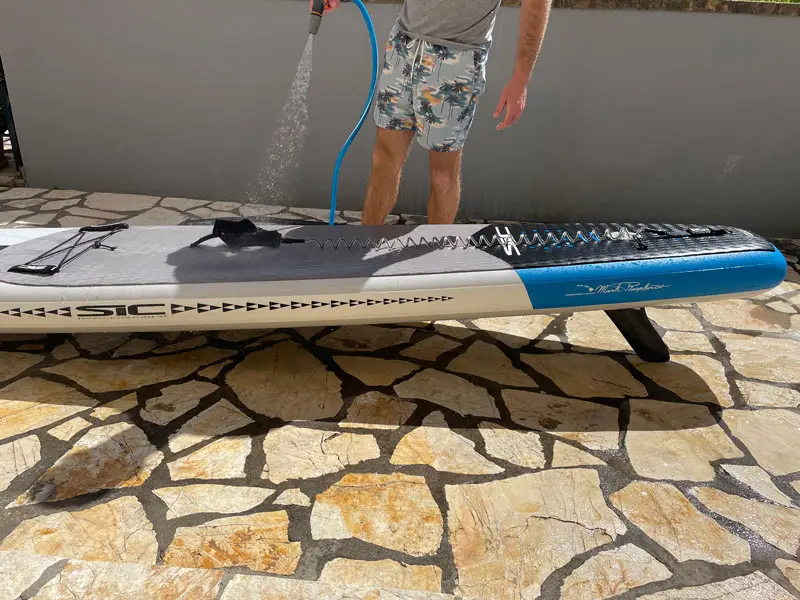
If you don’t live in an area with direct waterfront access, try and choose a launching location that has access to fresh water, such as a beach shower or hose. For paddling more remote beaches, you can bring a jerry can of fresh water with you or rinse your board when you get home. Do not leave a salty paddle board in storage for longer than a few days!
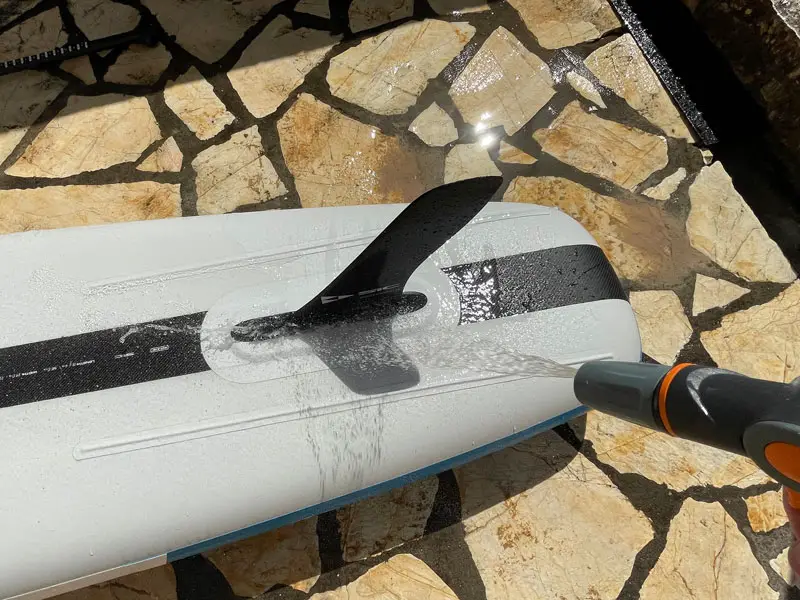
Take extra care to ensure you thoroughly rinse your paddle, the fin box, and any other accessories attachment points, such as GoPro mounts or bungee net D-rings that may have metal fittings. If left in contact with salt, they will quickly corrode and become unusable.
Remove The Fins
It is almost impossible to fold and pack away an inflatable paddle board with the fins still in place. Trying to do so will damage the fins, the board, or both. You will find it much easier to remove the fins while the board is still fully inflated, so don’t forget this step.
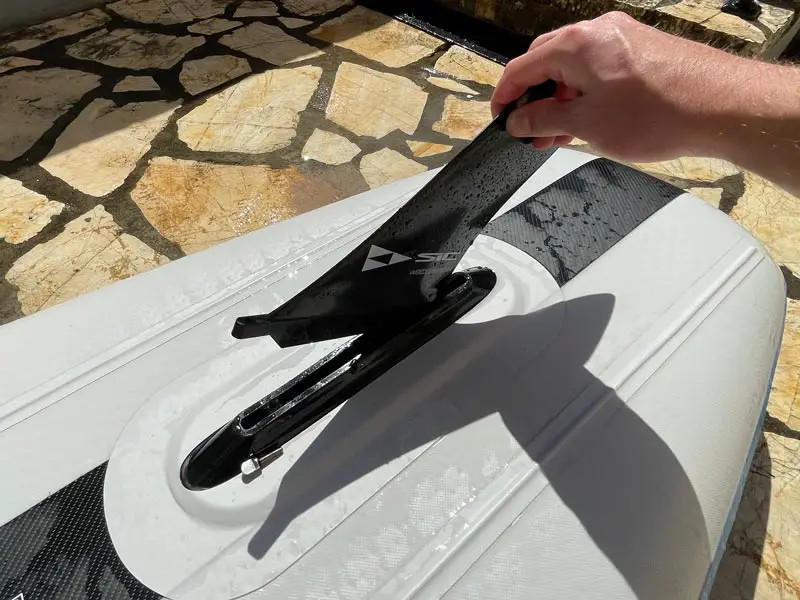
Removable paddle board fin boxes come in several styles, including slide-in, snap-in, dual tab, and as pictured here, the US fin box. All fin box styles will trap a small quantity of water inside them, so use a piece of fabric like the corner of a towel to dry inside the fin box.
Dry The Board
If you plan to use your board again in the next few days, then it is possible to skip this step. It is, however, very important that the board is dry when being stored, particularly if being stored for a long period of time. Letting the board sit damp in storage over several weeks will allow mold and mildew to grow and may even cause the deck pad to separate from the board.
If you have time, you can simply leave the board to dry naturally outside. although be cautious about leaving the board fully inflated in direct sun on hot days for the risk of causing overexpansion damage. In a rush to get packed up and go home? Simply give the board a rub down with a dry towel and then leave it for a few minutes in the sun to finish off.
Deflate The Paddle Board By Opening the Air Release Valve
Open the valve by pushing down with your finger and turning the pin. Air will rush out at high pressure and create a loud hissing sound. If you find that the sound attracts too much attention and want to be more courteous, Red Paddle makes a silencer for deflating your board.
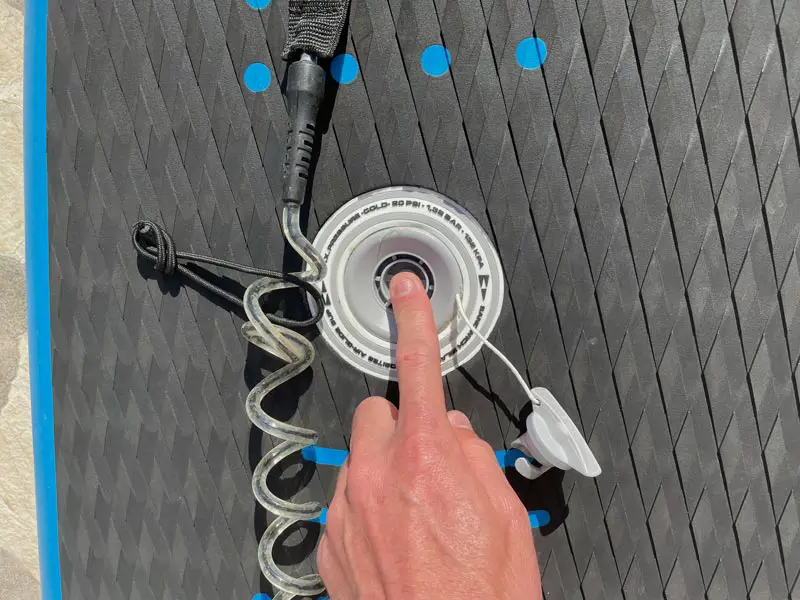
Leave the board to deflate for a few minutes. With the valve open, it will slowly go flat, so there is no need to waste your energy to help it at this stage.
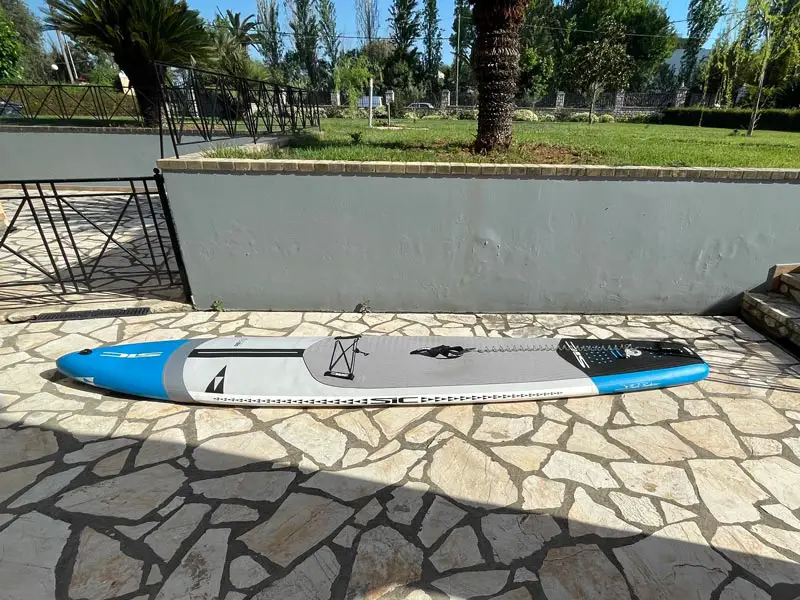
Remove the Last of the Air from the Board
To get a tight fold and neatly packed away paddle board, you will need to assist in the removal of the last remaining air from the board. The simplest way to do this is to tightly fold the board from nose to tail, squeezing the air out from the valve as you fold, like getting the last toothpaste out of the tube.

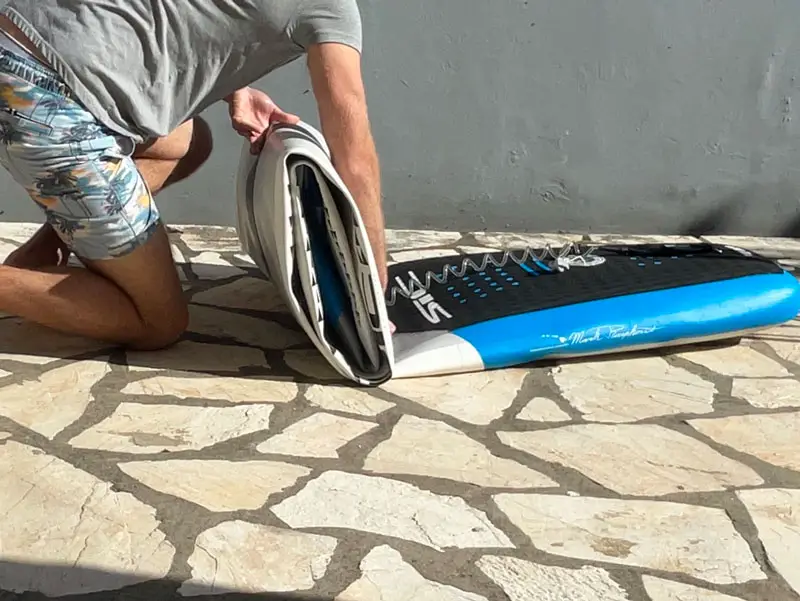
When you get to the final fold, you will find that the fin box prevents you from folding further. for this final section, you will need to use your hands and body weight to press down on any area that still contains air gently. Once all of the air has been squeezed out of the board, close the valve by pushing down on the pin and turning 90 degrees clockwise and then screw the dust cap back in. Closing the valve will prevent air from flowing back into the board, caused by its natural elasticity.
Deflating A Paddle Board With A Pump
Some pumps, both manual and electric pumps, have the ability to deflate as well as inflate. So, should you use your pump to deflate your board? This is up to you. Certainly, with a manual pump, it makes little to no difference in the ease or effort required to deflate your paddle board. Electric pumps will do all of the work for you.
However, if you decide to use a pump to deflate your paddle board, do not over-deflate your board. The board should be deflated and flat but not vacuum-packed. If you vacuum pack your board, it will form small creases which are detrimental to the lifespan of your board and can even cause the PVC material to crack and split.
How To Fold A Paddle Board
Lay the Deflated Paddle Board Out Flat
Now that your paddle board is fully deflated, the first step is to unroll it all out again. The reason behind this apparent step backward is that while you need to fold it from nose to tail to remove the air, to get a tight fold, the paddle board must be folded around the fin box.
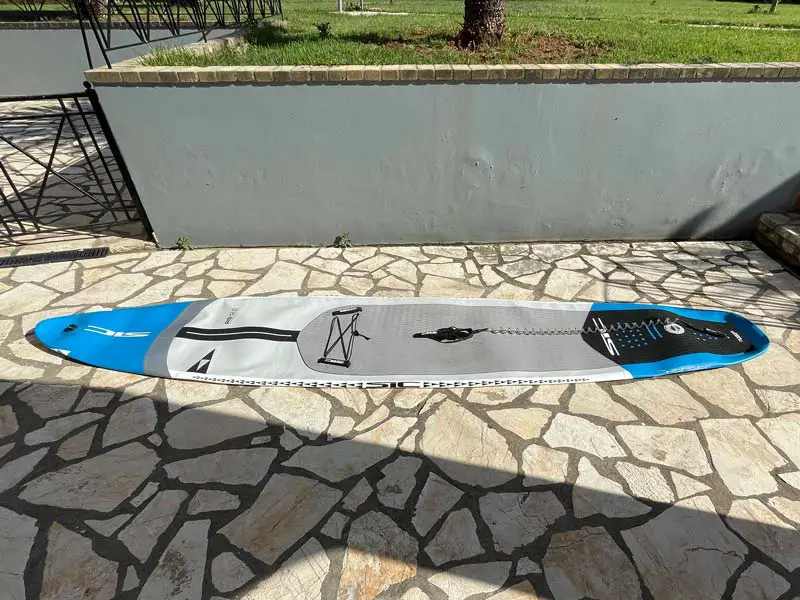
Carefully Fold The Board Around The Fin Box
Starting at the back of the board, begin to fold the paddle board over on itself using the fin box as a guide for the length of the folds. There may be some board behind the fin box, which can be folded under before you make your first fold.
It is important that the fin box is left flat and that the folds of the board aren’t too tight close to the edges of the fin box. Doing so can, over time cause the PVC holding the fin box in place to separate from the rest of the board.
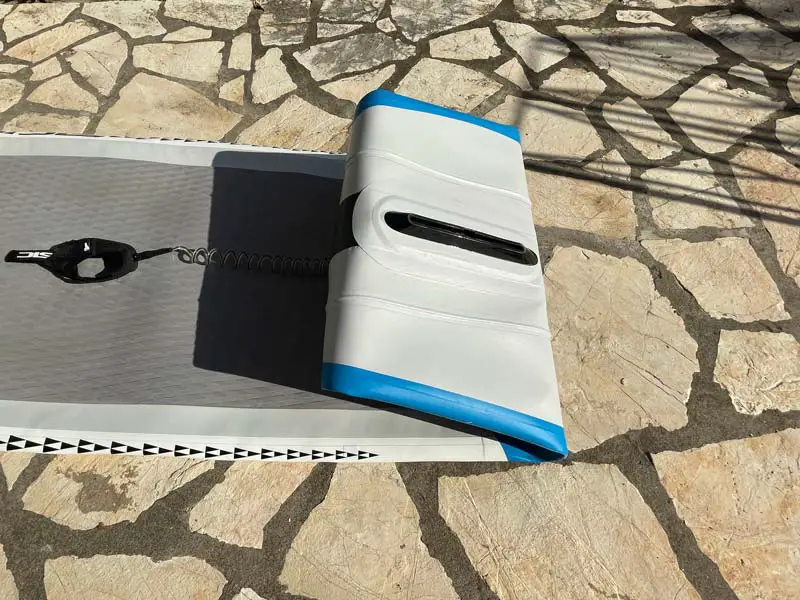
Keep folding the board from the back towards the front, keeping a consistent but moderately tight roll. It shouldn’t be tightly rolled like a yoga mat, nor should it be too loose that it unravels when you try to pick it up.
As you are folding the board, this is a good opportunity to wipe it down with a towel to remove any sand or stones that may end up in your carry bag.

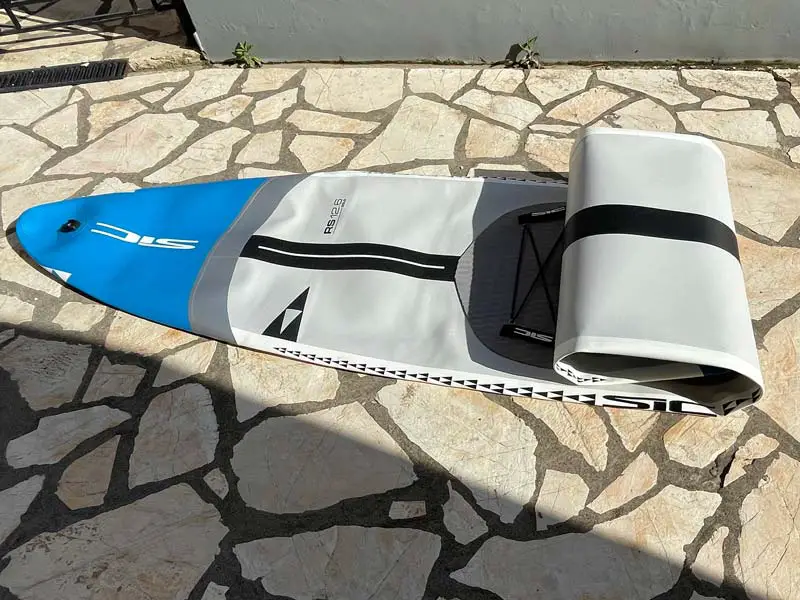
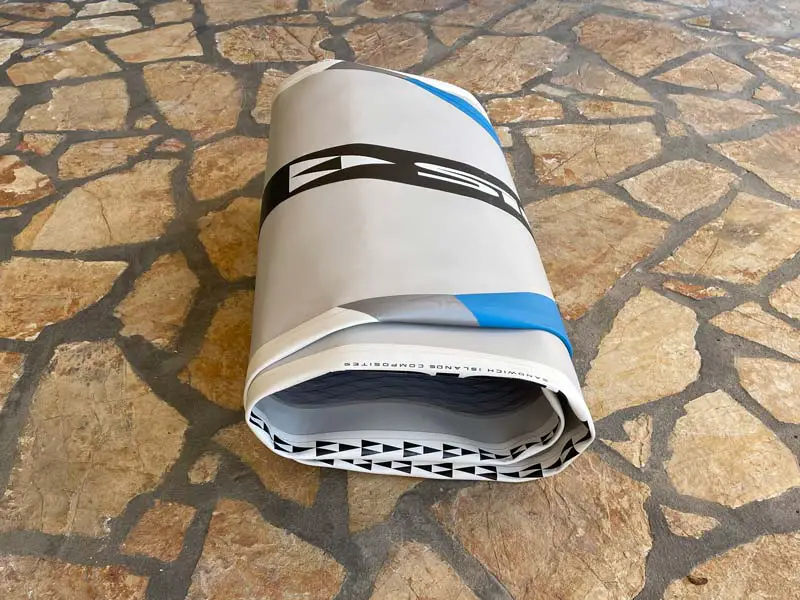
Secure The Board With A Strap and Place It Into The Carry Bag
Put the compression strap around the middle of the folded-up board, clip it into place and pull to tighten. This will stop the board from unraveling and undoing all of your work.


With the board tightly secured with the compression strap, put the paddle board, pump, and paddle into the carry bag. The bag may have extra straps to secure the board inside the bag. Using these straps will stop the board from putting pressure on the zips.
Zip Up The Bag
Close the bag using the zip, and you are ready to put your paddle board in the car, store it in the garage, or carry it to your next location.
Folding A Paddle Board With Multiple Fins
You can still easily fold your paddle board if it has a different fin setup, such as a three-fin layout, which is most common on all-around and surf inflatable paddle boards. Depending on where the fins are in relation to each other, you will need to make a fold between the main fin and the booster side fins. This can clearly be seen in the video below.
